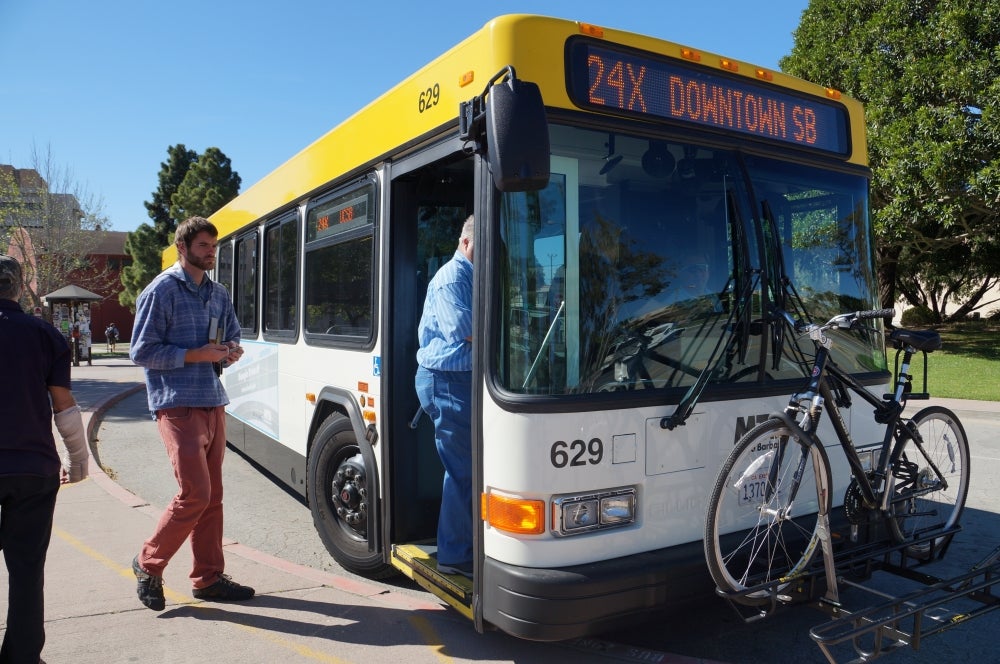
Here Comes the Bus
Thanks to a partnership between UC Santa Barbara and Metropolitan Transit District (MTD), plans for enhanced bus service to and from the UCSB campus are locked in. Riders could start to see changes by fall of 2015.
“It’s a win for the campus, it’s a win for our partners at MTD and a win for the larger community,” said Marc Fisher, UCSB senior associate vice chancellor for administrative services.
In a nutshell, bus routes 12x and 24x — two interlinked routes that take riders from downtown Santa Barbara to the UCSB campus and Isla Vista and back — will extend their hours of operation and reduce wait times. Those enhancements are currently scheduled to be in place by August 2015.
Additionally, a new Goleta-Isla Vista-UCSB route — Line 38 — is also planned. It is proposed to run from approximately 7:30 a.m. to 11:45 p.m. Monday through Friday, and to 10:45 p.m. on Saturday and 9:45 p.m. on Sunday. This new bus line will have wait times between 15 and 30 minutes, and it will be free for UCSB students, faculty and staff with photo IDs. This bus line could be in service as early as the fall of 2016, depending upon occupancy of the proposed San Joaquin student housing project.
The enhanced and new transit service is in response to the San Joaquin project proposed as part of UC Santa Barbara’s Long Range Development Plan (LRDP), a plan for the growth of the campus. The LRDP proposes an increase in student and faculty/staff populations as well as the physical infrastructure necessary to support the larger populations. The LRDP, approved by the UC Regents in 2010, is currently before the California Coastal Commission.
Potential growth associated with bus ridership and the related impact on MTD services was the impetus for the discussions that led to this partnership. In addition, the campus, with strong support from the local environmental group Sustainable University Now (SUN), was looking for ways to reduce its parking requirement. According to Fisher, recent trends show students are bringing fewer cars to campus and have increased use of transit and bicycles.
“It didn’t make sense for us to build a huge amount of parking if we thought it was going to sit empty,” he said. In the past, parking requirements necessitated the overbuilding of parking spaces to meet the never-realized need. The campus already has significant additional capacity, he said, which could be used should the need arise.
The issue then became how to provide strong and consistent service to move students back and forth between their homes and campus, to jobs, local retail and entertainment venues, or to and from the extra-capacity parking. Given that the university was not interested in operating its own bus line, and providing a proprietary shuttle service was another layer of expense and effort, the plan, after months of consultation with MTD, boiled down to enhancing existing services to and from campus and creating a new bus line that will link the students from existing and proposed housing along and around El Colegio Road to the campus and the community.
“We’re very pleased UCSB and MTD are partnering to provide enhanced transit service to serve the UCSB students, faculty, staff and their families,” said MTD General Manager Sherrie Fisher. “We’re especially happy that the service funded by UCSB will not only serve campus but also other popular destinations served by bus routes emanating from UCSB and Isla Vista that have often been at capacity, such as Camino Real Marketplace, Goleta Old Town and downtown Santa Barbara. MTD looks forward to implementing the service and knows that it will benefit the community overall.”
The annual cost to the university for the enhanced transit — in the neighborhood of $1.3 million — pales in comparison to the cost of building a new and potentially underutilized parking structure. The enhanced transit service not only honors the university’s agreement with SUN to attempt to reduce development associated with parking, it de-incentivizes the use of cars and has earned MTD’s support before the Coastal Commission for one of the LRDP’s first major projects, San Joaquin Village. San Joaquin Village is a housing development that adds 1,000 student beds in approximately 167 apartment units. The project surrounds the Santa Catalina student housing at Storke and El Colegio Roads.
The bus services also will solve help the long-standing problem students have had finding transit service in the later evening, allowing them to come to campus later or stay longer. Those who are not students, staff or faculty at the university can also ride the new line, which essentially travels from the main campus bus circle west along El Colegio Road and north along Storke Road, then circles clockwise around the Camino Real Marketplace along Phelps Road, Pacific Oaks Road, Santa Felicia Drive and Hollister Avenue before heading back south on Storke Road and returning to campus via El Colegio.
The campus reaction “has been very positive,” said Marc Fisher, and the partnership forged between MTD and the campus opens up future discussions for similar UCSB development projects.



